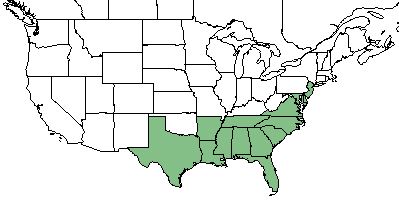Smilax walteri
| Smilax walteri | |
|---|---|

| |
| Photo by Craig Huegel hosted at Atlas of Florida Plants | |
| Scientific classification | |
| Kingdom: | Plantae |
| Division: | Magnoliophyta - Flowering plants |
| Class: | Liliopsida - Moncots |
| Order: | Lilales |
| Family: | Smilacaceae |
| Genus: | Smilax |
| Species: | S. walteri |
| Binomial name | |
| Smilax walteri Pursh | |

| |
| Natural range of Smilax walteri from USDA NRCS [1]. | |
Common Name(s): coral greenbriar;[1][2] red-berried swamp smilax[1]
Contents
Taxonomic Notes
Synonym(s): S. megacarpa[2]
Description
Smilax walteri is a monoecious perennial shrub or vine.[2]
Distribution
This species is found on the coastal plain from the eastern edge of Texas, eastward to central peninsular Florida, north to New Jersey and inland to Tennessee.[1][2]
Ecology
Habitat
S. walteri has been found in cypress-gum ponds, titi cypress depressions, lake edges, swampy woodlands, marshy areas, and longleaf pine forests.[3] It is also found in disturbed areas like ditches between pine-oak woodlands.[3] Associated species: Lyonia lucida, Leucothoe racemosa, Vibrunum nudum, Lyonia ligustrina, and Cyrilla racemiflora.[3] In the Okefenokee Swamp, southern Georgia, S. walteri had an above water biomass of 12 g m-2 with a productivity of 6 g m-2 yr-1.[4] In Tupelo gum-Cypress-swamp black gum communities of Alabama, S. walteri occurred at densities of 12 acre-1 (30 hm-2).[5]S. walteri is found in swamp forests, bogs, and other areas that are often submerged for a portion of the year.[1]
Phenology
Flowering occurs from April through May and fruiting occurs from September through November but can persist beyond.[1]
Fire ecology
Populations of Smilax walteri have been known to persist through repeated annual burning.[6]
Herbivory and toxicology
Fruit remains of S. walteri have been found in deer pellets during May in eastern Texas.[7] Its fruits are also consumed by a variety of birds.[8] Leaves and twigs are consumed by the Florida marsh rabbit (Sylvilagus palustris paludicola).[9]
Conservation, cultivation, and restoration
Cultural use
There are many species of Smilax and it is thought they can all be used in similar ways. Historically, the roots were harvested and prepared in a red flour or a thick jelly that could be used in candies and sweet drinks. Our first known written account of using the plant roots to make this jelly is from the journal of Captain John Smith in 1626. Other travelers throughout US history have made note of the uses of Smilax plants. We know the flour was used in breads and soups, and that a drink very similar to Sarsaparilla could be prepared.[10]
Photo Gallery
References and notes
- ↑ 1.0 1.1 1.2 1.3 1.4 Weakley AS (2015) Flora of the Southern and Mid-Atlantic States. Chapel Hill, NC: University of North Carolina Herbarium.
- ↑ 2.0 2.1 2.2 2.3 USDA NRCS (2016) The PLANTS Database (http://plants.usda.gov, 19 January 2018). National Plant Data Team, Greensboro, NC 27401-4901 USA.
- ↑ 3.0 3.1 3.2 Florida State University Herbarium Database. URL: http://herbarium.bio.fsu.edu. Last accessed: June 2021. Collectors: Loran C. Anderson and Robert K. Godfrey. States and counties: Florida: Jefferson, Leon, Wakulla, and Washington. Georgia: Thomas.
- ↑ Schlesinger WH (1978) On the relative dominance of shrubs in Okefenokee Swamp. The American Naturalist 112(987):949-954.
- ↑ Hall TF, Penfound WT (1943) Cypress-gum communities in the blue girth swamp near Selma, Alabama. Ecology 24(2):208-217.
- ↑ Platt, W.J., R. Carter, G. Nelson, W. Baker, S. Hermann, J. Kane, L. Anderson, M. Smith, K. Robertson. 2021. Unpublished species list of Wade Tract old-growth longleaf pine savanna, Thomasville, Georgia.
- ↑ Lay DW (1965) Fruit utilization by deer in southern forests. The Journal of Wildlife Management 29(2):370-375.
- ↑ White DW, Stiles EW (1992) Bird dispersal of fruits of species introduced into eastern North America. Canadian Journal of Botany 70:1689-1696.
- ↑ Blair WF (1936) The Florida marsh rabbit. Journal of Mammalogy 17(3):197-207.
- ↑ Fernald, et al. 1958. Edible Plants of Eastern North America. Harper and Row Publishers, New York.